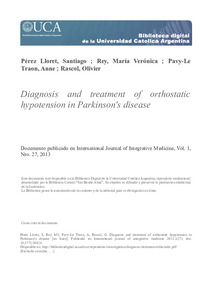Please use this identifier to cite or link to this item:
https://repositorio.uca.edu.ar/handle/123456789/1640| Título: | Diagnosis and treatment of orthostatic hypotension in Parkinson's disease | Autor: | Pérez Lloret, Santiago Rey, Verónica Pavy-Le Traon, Anne Rascol, Olivier |
Palabras clave: | ENFERMEDADES NEUROGENERATIVAS; ENFERMEDAD DE PARKINSON; TRATAMIENTO; HIPOTENSION ORTOSTATICA | Fecha de publicación: | 2013 | Editorial: | InTech | Cita: | Pérez Lloret, S., Rey M.V., Pavy-Le Traon, A., Rascol, O. Diagnosis and treatment of orthostatic hypotension in Parkinson's disease [en línea]. International Journal of Integrative Medicine. 2013, 1 (27). doi: 10.5772/56924. Disponible en: https://repositorio.uca.edu.ar/handle/123456789/1640 | Resumen: | Abstract: Orthostatic hypotension (OH) is a frequent comorbidity affecting between 23 and 38% of Parkinson’s disease (PD) patients. Several pieces of evidence suggest that OH is related to faster cognitive decline and more frequent falls, and has been also connected to increased mortality. OH can be arbitrarily defined as a drop of systolic and/or diastolic blood pressure of 20 or 10 mmHg or more in the first three minutes after passing from decubitus to an upright position. Till test appears to be the most reliable tool for assessing the orthostatic response. On the other hand, the standing test and evaluation of orthostatic symptoms should be regarded as screening tests. The key physiopathological aspect of OH is an altered baroreflex function resulting from cardiac and vascular sympathetic denervation. Nonetheless, OH can be aggravated by heat, alcohol consumption or by drug treatments, such as antihypertensives, dopamine agonists or amantadine. Treatment should begin with re‐considering drug treatments. After treatment is optimized, nonpharmacological measures may be employed. Drugs treatment should be reserved for patients in whom other strategies have failed. Midodrine and fludrocortisone are the most frequently used treatments, even though evidence about their efficacy and safety is weak. Midodrine has a shorter duration of action and thus avoidance of evening dosing may help keep nocturnal blood pressure dipping intact. Promising alternatives may include droxidopa and fipamezole | URI: | https://repositorio.uca.edu.ar/handle/123456789/1640 | ISSN: | 1848-8846 | Disciplina: | MEDICINA | DOI: | 10.5772/56924 | Derechos: | Acceso Abierto | Fuente: | Journal of Integrative Medicine, Vol. 1, Nro. 27, 2013 |
| Appears in Collections: | Artículos |
Files in This Item:
| File | Description | Size | Format | |
|---|---|---|---|---|
| diagnosis-treatment-orthostatic.pdf | 464,26 kB | Adobe PDF |  View/Open |
Page view(s)
167
checked on Apr 30, 2024
Download(s)
205
checked on Apr 30, 2024
Google ScholarTM
Check
Altmetric
Altmetric
This item is licensed under a Creative Commons License

